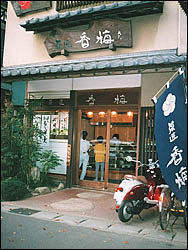![]()
We chose to study Japanese sweets because we were fascinated by their exquisite beauty and good taste. Japanese sweets are made mostly of grains, beans, fruit and wild plants. The many different varieties incorporate a vivid sense of the seasons. In order to learn more about Japanese sweets, we visited Kobai, a Japanese confectionery in Yachiyo, Chiba, and talked to confectioners there. They gave us the following information. Western-style sweets are popular in present day Japan, making Japanese sweets seem rather plain and old-fashioned in comparison. Japanese sweets originated in the Yayoi Era (200 B.C.-200 A.D), at which time they were made of baked rice and dried potatoes. Later, bean-filled cakes (manju) and other sweets were brought from China by Japanese envoys and by Chinese monks who came to Japan to teach Buddhism. As tea ceremony became more popular, techniques for manufacturing sweets advanced along with Japanese culture. In the Edo Era (1603-1867), they came to be enjoyed by the masses rather than just the elite. People from Portugal and the Netherlands brought kompeito (star-shaped candies), kasutera (sponge cake), caramels and other candies to Tanegashima Island and the Kyushu area of Japan. The names yogashi (Western-style sweets) and wagashi (Japanese sweets) were adopted in the Meiji Era (1868-1912). Japanese confectioners are very industrious, creating sweets to suit every era by incorporating new ingredients such as butter and cheese. At Kobai, we wake up at three or four in the morning to prepare 150 pieces of each variety. We also make traditional sweets to serve at tea ceremonies and special sweets designed according to customers' orders. Japanese confectioners work hard at making traditional Japanese sweets that are also innovative enough to appeal to modern Japan. By talking with the confectioners at Kobai, we understood the pride that they take in their work. |
| Access to Kobai, Japanese confectionery in Yachiyo City, Chiba Take the Keisei Line to Katsutadai Station. It's a five-minute walk from the station. |
 |
